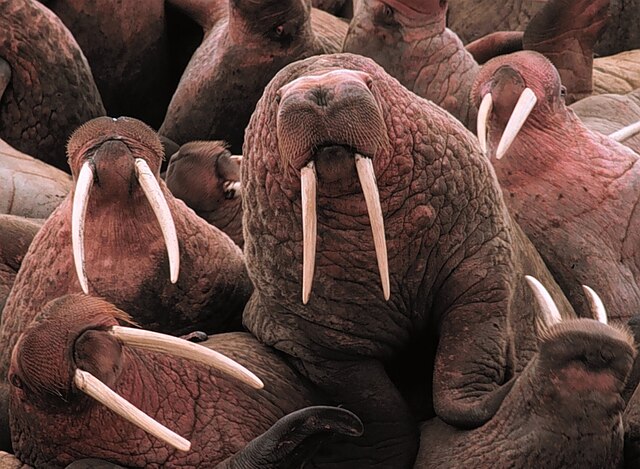Ivory is a hard, white material from the tusks and teeth of animals, that consists mainly of dentine, one of the physical structures of teeth and tusks. The chemical structure of the teeth and tusks of mammals is the same, regardless of the species of origin, but ivory contains structures of mineralised collagen. The trade in certain teeth and tusks other than elephant is well established and widespread; therefore, "ivory" can correctly be used to describe any mammalian teeth or tusks of commercial interest which are large enough to be carved or scrimshawed.
11th-century Italian carved elephant tusk, Louvre.
Cylindrical ivory casket, Siculo-Arabic, Hunt Museum.
A depiction of the Blessed Virgin Mary and the Child Jesus crafted in elephant ivory
An ivory tabernacle featuring the Madonna of Caress, France
Tusks are elongated, continuously growing front teeth that protrude well beyond the mouth of certain mammal species. They are most commonly canine teeth, as with narwhals, chevrotains, musk deer, water deer, muntjac, pigs, peccaries, hippopotamuses and walruses, or, in the case of elephants, elongated incisors. Tusks share common features such as extra-oral position, growth pattern, composition and structure, and lack of contribution to ingestion. Tusks are thought to have adapted to the extra-oral environments, like dry or aquatic or arctic. In most tusked species both the males and the females have tusks although the males' are larger. Most mammals with tusks have a pair of them growing out from either side of the mouth. Tusks are generally curved and have a smooth, continuous surface. The male narwhal's straight single helical tusk, which usually grows out from the left of the mouth, is an exception to the typical features of tusks described above. Continuous growth of tusks is enabled by formative tissues in the apical openings of the roots of the teeth.

An African elephant in Tanzania, with visible tusks
Tusks of "Mammut" borsoni from Greece, which are the longest tusks ever recorded.
Walruses
Skull of Babyrousa celebensis, showing long upward curving canine tusks








